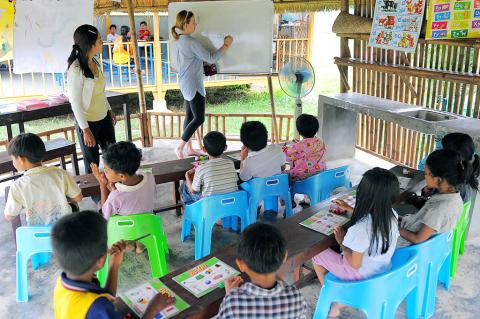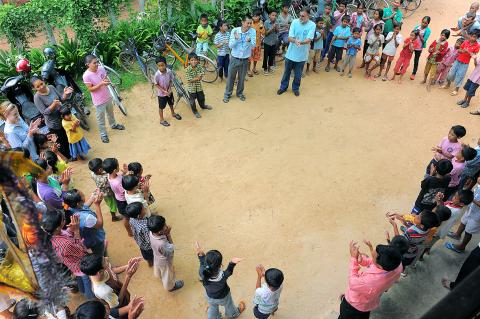Pictures of hundreds of former volunteers line the walls of a muddy courtyard in Cambodia’s tourist hub of Siem Reap, their faces once familiar to the orphans playing there but now long gone.
The colorful gallery at the Acodo orphanage illustrates a growing trend of holidaymakers donating their time and skills to children in the impoverished country — but experts fear they could be doing more harm than good.
Marissa Soroudi, a student in her 20s from New York, is one of the many volunteers teaching English at Acodo, near the famed temples of Angkor and home to more than 60 orphans between the ages of three and 18.

Photo: AFP
The young American, who pays US$50 a week to work at the orphanage, plans to stay for a few days before traveling on but she knows it is tough on the children to watch volunteers like her come and go.
“There are so many people volunteering that it’s kind of like, one leaves and another swoops in,” she said.
“They say better not to talk about it with them. Don’t say ‘I’m leaving in a week,’ don’t do any of that because then they get upset. Better to just not come.”

Photo: AFP
Short-term volunteers may have good intentions, but childcare experts say they are putting some of the most vulnerable children at risk.
“Constant change of caregivers gives emotional loss to children, constant emotional loss to already traumatized children,” Jolanda van Westering, a child protection specialist at the United Nations Children’s Fund (UNICEF) said. “And the constant exposure to strangers poses risks of harm, of violence and abuse, because we know that oftentimes volunteers come to an orphanage without having their backgrounds checked.”
As the gateway to the ancient temples of Angkor — which attract more than a million visitors a year — a steady stream of tourists passes through the sleepy riverside town.
And many want to do more than just sightsee in one of the region’s poorest nations.
On notice boards in hotels, cafes and souvenir shops, wide-eyed children stare from posters for schools and orphanages, encouraging travelers to donate time and money for their particular cause.
“Visitors see some poverty and they feel bad about it,” said Ashlee Chapman, a project manager with Globalteer, an organization that matches volunteers with local organizations.
“They want to do something,” she adds, saying they might visit a children’s project for a few hours, donate money and toys, “take a holiday snap and feel that they’ve contributed.”
As the so-called volunteer tourism sector flourishes, so too does the number of institutions housing children.
In the past six years, the number of orphanages in Cambodia has almost doubled to 269, housing some 12,000 children, according to UNICEF.
Friends International, a local organization that works with marginalized urban children and youths, says tourism has contributed to the increase.
Visiting orphanages has become a tourist “attraction” in big cities like Phnom Penh and Siem Reap, said Marie Courcel, alternative care project manager at Friends International.
That in turn encourages the institutionalization of youngsters, many of whom are very poor but actually have at least one living parent, she said.
Only one in 10 of the orphanages are funded by the state, the rest rely on charitable contributions to survive.
At Siem Reap’s Acodo, huddled with the children in the shade of the only tree, Soroudi organizes the afternoon activity.
Following her lead, the orphans make headpieces out of grass and add licks of paint to green and yellow conical hats, costumes they will wear in that evening’s traditional Khmer dance show.
The daily half-hour event attracts a tourist crowd who thank the young performers with donations of money.
Van Westering said she worried about the dangers for children who are expected to raise funds for their care by begging or putting on shows for tourists.
“They have to do their best and they hear that also if they don’t there isn’t enough money for their care,” said Van Westering. “You can just imagine what that does to children to live in that kind of insecure environment.”
Her advice to tourists pondering a brief working stint at an orphanage is simple: “Don’t go. Give blood, support a community-based organization that provides day activities for a child but where the children go home at night.”
Betsy Brittenham, an interior designer in her 50s from Arizona, and her 15-year-old daughter Alex are spending three weeks as volunteer teachers at one such place, the Grace House Community Centre, where the children return to their families each evening.
The mother and daughter team, who planned their trip months in advance, say volunteering at a reputable center is a chance to make a difference in a country with fewer resources and opportunities than their own.
Like the volunteers at Acodo, Betsy pays for the privilege of working on her holiday but she sees no downsides to the experience.
“When you volunteer like this you’re bringing your money and you’re making tremendous strides and teaching their children,” she said. “It’s something you can’t put a price on.”

May 11 to May 18 The original Taichung Railway Station was long thought to have been completely razed. Opening on May 15, 1905, the one-story wooden structure soon outgrew its purpose and was replaced in 1917 by a grandiose, Western-style station. During construction on the third-generation station in 2017, workers discovered the service pit for the original station’s locomotive depot. A year later, a small wooden building on site was determined by historians to be the first stationmaster’s office, built around 1908. With these findings, the Taichung Railway Station Cultural Park now boasts that it has

Wooden houses wedged between concrete, crumbling brick facades with roofs gaping to the sky, and tiled art deco buildings down narrow alleyways: Taichung Central District’s (中區) aging architecture reveals both the allure and reality of the old downtown. From Indigenous settlement to capital under Qing Dynasty rule through to Japanese colonization, Taichung’s Central District holds a long and layered history. The bygone beauty of its streets once earned it the nickname “Little Kyoto.” Since the late eighties, however, the shifting of economic and government centers westward signaled a gradual decline in the area’s evolving fortunes. With the regeneration of the once

The latest Formosa poll released at the end of last month shows confidence in President William Lai (賴清德) plunged 8.1 percent, while satisfaction with the Lai administration fared worse with a drop of 8.5 percent. Those lacking confidence in Lai jumped by 6 percent and dissatisfaction in his administration spiked up 6.7 percent. Confidence in Lai is still strong at 48.6 percent, compared to 43 percent lacking confidence — but this is his worst result overall since he took office. For the first time, dissatisfaction with his administration surpassed satisfaction, 47.3 to 47.1 percent. Though statistically a tie, for most

In February of this year the Taipei Times reported on the visit of Lienchiang County Commissioner Wang Chung-ming (王忠銘) of the Chinese Nationalist Party (KMT) and a delegation to a lantern festival in Fuzhou’s Mawei District in Fujian Province. “Today, Mawei and Matsu jointly marked the lantern festival,” Wang was quoted as saying, adding that both sides “being of one people,” is a cause for joy. Wang was passing around a common claim of officials of the People’s Republic of China (PRC) and the PRC’s allies and supporters in Taiwan — KMT and the Taiwan People’s Party — and elsewhere: Taiwan and